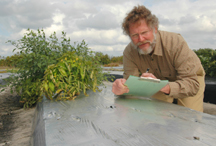 With
this month's federal ban on most uses of methyl bromide,
University of Florida
scientists are searching for alternatives to the widely used
soil fumigant that is essential for the production of
fruits, vegetables and ornamentals in Florida and the
nation.
With
this month's federal ban on most uses of methyl bromide,
University of Florida
scientists are searching for alternatives to the widely used
soil fumigant that is essential for the production of
fruits, vegetables and ornamentals in Florida and the
nation.
The
fumigant, which controls soil pests and weeds, was banned by
the Environmental Protection Agency in response to the
Montreal Protocol international treaty because the chemical
harms the Earth's ozone layer, reducing its ability to
protect the planet from radiation. Only a few emergency uses
of the fumigant are still permitted.
"Finding
a replacement that will be as cost-effective as methyl
bromide is proving to be difficult, but we do have some
promising new materials and approaches to help growers
protect their crops and the environment," said Jim Gilreath,
a professor of horticultural sciences at UF's
Institute of Food and
Agricultural Sciences.
He said
many fumigants such as Chloropicrin, Telone C-35, Inline and
Vapam are being evaluated, alone and in combination. Recent
tests showed that a combination of Telone C-35 and Tillam
herbicide produced good results on tomatoes, but the
manufacturer of Tillam went out of business, and the product
is not currently registered for use.
"As we
continue to look for alternatives for methyl bromide, we
have found that the use of new virtually impermeable film
and metalized film covers on plant beds allow growers to
reduce their use of the fumigant by as much as 50 percent,"
he said. "When it comes to holding or keeping fumigants in
the soil, these high-barrier mulch films are far superior to
conventional polyethylene mulch films that have been used by
growers for the past 30 years."
Gilreath,
who leads the soil fumigation research program at UF's Gulf
Coast Research and Education Center in Wimauma, said his
research findings were quickly adopted by growers this year.
Almost every tomato farm in Florida is now using metalized
film on some part of its acreage along with the one-half
rate of methyl bromide.
"In fact,
several of the larger tomato producers shifted all of their
acreage to metalized film in the Southeast - from Florida to
the Delmarva peninsula in Virginia - based on results from
our research," Gilreath said. "Growers have been very
satisfied with the results and plan to continue using the
highly retentive films."
He said
the savings in the cost of methyl bromide - along with more
equitable distribution of limited supplies of the fumigant
and reduced impact on the ozone layer - have made this
approach very successful.
Gilreath,
who works in cooperation with Joe Noling, a professor of
nematology at UF's Citrus Research and Education Center in
Lake Alfred, and Dan Chellemi, a pathologist at the U.S.
Department of Agriculture's Horticultural Research
Laboratory in Fort Pierce, said they began testing different
types of films about eight years ago in an effort to reduce
the need for methyl bromide.
"Two
years ago, we began working with metalized films because
they also reduce the movement of silverleaf whiteflies and
viruses they transmit," he said. "We tested the metalized
films with methyl bromide and a product called Inline, which
is Telone C-35 mixed with an emulsifier so that it can be
injected through drip irrigation lines in the plant beds."
In each
case, application of methyl bromide and Inline in
conjunction with metalized film greatly increased retention
of the fumigant in the plant beds, providing effective
control of soil-borne pests, especially hard-to-control
weeds such as nutsedge, he said.
Effective
nutsedge control was obtained with 175 pounds of methyl
bromide per acre under metalized film, which was superior to
that obtained with 350 pounds of fumigant per acre under
conventional polyethylene film.
"While it
is possible to use either metalized or virtually impermeable
film to reduce methyl bromide application rates by one-half,
success involves more than just laying the film over the
plant bed and reducing the amount of the fumigant," Gilreath
said. "Success requires close monitoring of the fumigant
delivery system to make sure that the gas is applied
uniformly in the bed through all three gas knives."
He said
nonuniform application guarantees poor fumigant performance
at any rate, and the downside results can be even more
dramatic with reduced rates of methyl bromide. Before trying
rate reductions, growers should modify their fumigation
equipment to allow better control over uniformity of flow,
which can mean the difference between success and failure.
Meanwhile, until an effective replacement for methyl bromide
is found, growers are also relying on critical use
exemptions granted by the United Nations Environmental
Programme on a year-to-year basis. The Florida Fruit and
Vegetable Association is currently seeking exemptions for
producers through the 2006 and 2007 growing seasons.
By
Chuck Woods